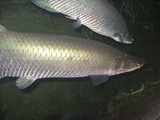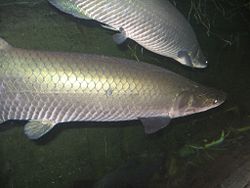
Omagua
Encyclopedia
Omagua or Low Jungle is one of the eight Natural Regions of Peru
. It is located between 80 and 400 m above sea level in the Amazon rainforest
. In this region, there are a lot of rivers that create meander
s, swamp
s and lagoon
s.
The flora
includes trees like cedar, palms
(e.g. genus Phytelephas
), and Shapaja (Attalea
butyracea). There are also plants like the Cattleya
rex, a species of orchid
.
 The fauna
The fauna
includes animals like the Capybara
(which is the biggest rodent
in the world), the Giant Armadillo
, the Jaguar
, the Giant Otter
, and the Red Brocket Deer. There are also numerous species of birds, including the White-throated Toucan
, the Hoatzin
, and the Red-and-green Macaw
. Animals that live in the water include the Arapaima
, and the Amazonian Manatee
.
Mountain Top:
Peru
Peru , officially the Republic of Peru , is a country in western South America. It is bordered on the north by Ecuador and Colombia, on the east by Brazil, on the southeast by Bolivia, on the south by Chile, and on the west by the Pacific Ocean....
. It is located between 80 and 400 m above sea level in the Amazon rainforest
Amazon Rainforest
The Amazon Rainforest , also known in English as Amazonia or the Amazon Jungle, is a moist broadleaf forest that covers most of the Amazon Basin of South America...
. In this region, there are a lot of rivers that create meander
Meander
A meander in general is a bend in a sinuous watercourse. A meander is formed when the moving water in a stream erodes the outer banks and widens its valley. A stream of any volume may assume a meandering course, alternately eroding sediments from the outside of a bend and depositing them on the...
s, swamp
Swamp
A swamp is a wetland with some flooding of large areas of land by shallow bodies of water. A swamp generally has a large number of hammocks, or dry-land protrusions, covered by aquatic vegetation, or vegetation that tolerates periodical inundation. The two main types of swamp are "true" or swamp...
s and lagoon
Lagoon
A lagoon is a body of shallow sea water or brackish water separated from the sea by some form of barrier. The EU's habitat directive defines lagoons as "expanses of shallow coastal salt water, of varying salinity or water volume, wholly or partially separated from the sea by sand banks or shingle,...
s.
The flora
Flora
Flora is the plant life occurring in a particular region or time, generally the naturally occurring or indigenous—native plant life. The corresponding term for animals is fauna.-Etymology:...
includes trees like cedar, palms
Arecaceae
Arecaceae or Palmae , are a family of flowering plants, the only family in the monocot order Arecales. There are roughly 202 currently known genera with around 2600 species, most of which are restricted to tropical, subtropical, and warm temperate climates...
(e.g. genus Phytelephas
Phytelephas
Phytelephas is a genus containing six species of palms , occurring from southern Panama along the Andes to Ecuador, Bolivia and Peru. They are commonly known as ivory palms, ivory-nut palms or tagua palms; their scientific name means "plant elephant"...
), and Shapaja (Attalea
Attalea (genus)
Attalea is a large genus of palms native to Mexico, the Caribbean, Central and South America. This pinnately leaved, non-spiny genus includes both small palms lacking an aboveground stem and large trees. The genus has a complicated taxonomic history, and has often been split into four or five...
butyracea). There are also plants like the Cattleya
Cattleya
Cattleya is a genus of 113 species of orchids from Costa Rica to tropical South America. The genus was named in 1824 by John Lindley after Sir William Cattley who received and successfully cultivated specimens of Cattleya labiata that were used as packing material in a shipment of other orchids...
rex, a species of orchid
Orchidaceae
The Orchidaceae, commonly referred to as the orchid family, is a morphologically diverse and widespread family of monocots in the order Asparagales. Along with the Asteraceae, it is one of the two largest families of flowering plants, with between 21,950 and 26,049 currently accepted species,...
.

Fauna
Fauna or faunæ is all of the animal life of any particular region or time. The corresponding term for plants is flora.Zoologists and paleontologists use fauna to refer to a typical collection of animals found in a specific time or place, e.g. the "Sonoran Desert fauna" or the "Burgess shale fauna"...
includes animals like the Capybara
Capybara
The capybara , also known as capivara in Portuguese, and capibara, chigüire in Venezuela, Colombia, and Ecuador ronsoco in Peru, chigüiro, and carpincho in Spanish, is the largest living rodent in the world. Its closest relatives are agouti, chinchillas, coyphillas, and guinea pigs...
(which is the biggest rodent
Rodent
Rodentia is an order of mammals also known as rodents, characterised by two continuously growing incisors in the upper and lower jaws which must be kept short by gnawing....
in the world), the Giant Armadillo
Giant Armadillo
The giant armadillo , colloquially tatou, ocarro, tatu-canastra or tatú carreta, is the largest living species of armadillo...
, the Jaguar
Jaguar
The jaguar is a big cat, a feline in the Panthera genus, and is the only Panthera species found in the Americas. The jaguar is the third-largest feline after the tiger and the lion, and the largest in the Western Hemisphere. The jaguar's present range extends from Southern United States and Mexico...
, the Giant Otter
Giant Otter
The giant otter is a South American carnivorous mammal. It is the longest member of the Mustelidae, or weasel family, a globally successful group of predators. Unusually for a mustelid, the giant otter is a social species, with family groups typically supporting three to eight members...
, and the Red Brocket Deer. There are also numerous species of birds, including the White-throated Toucan
White-throated Toucan
The White-throated Toucan is a near-passerine bird found throughout the Amazon in south-eastern Colombia, eastern Ecuador, eastern Peru, northern Bolivia, southern and eastern Venezuela, northern and western Brazil, including the Amazon Basin's adjacent Tocantins-Araguaia River drainage, and the...
, the Hoatzin
Hoatzin
The Hoatzin , also known as the Hoactzin, Stinkbird, or Canje Pheasant, is a species of tropical bird found in swamps, riverine forest and mangrove of the Amazon and the Orinoco delta in South America...
, and the Red-and-green Macaw
Red-and-green Macaw
The Red-and-green Macaw , also known as the Green-winged Macaw, is a large mostly-red macaw of the Ara genus.This is the largest of the Ara genus, widespread in the forests and woodlands of northern and central South America...
. Animals that live in the water include the Arapaima
Arapaima
The arapaima, pirarucu, or paiche is a South American tropical freshwater fish. It is a living fossil and one of the largest freshwater fishes in the world.-Anatomy and morphology:...
, and the Amazonian Manatee
Amazonian Manatee
The Amazonian Manatee is a species of manatee that lives in the freshwater habitats of the Amazon basin. They are found in Brazil, Peru, Colombia, Ecuador, Guyana and Venezuela. Amazonian manatees are aquatic animals of the Sirenia order and are also known as "seacows". Their colour is grey but...
.
Overview
Andean Continental Divide| Westside | Eastside |
|---|---|
| Chala Chala The Chala or "Coast" is one of the eight natural regions in Peru. It is formed by all the western lands that arise from sea level up to the height of 500 meters.... , dry coast |
Lowland tropical rainforest Tropical rainforest A tropical rainforest is an ecosystem type that occurs roughly within the latitudes 28 degrees north or south of the equator . This ecosystem experiences high average temperatures and a significant amount of rainfall... or Selva baja |
| Maritime Yungas | Highland tropical rainforest Tropical rainforest A tropical rainforest is an ecosystem type that occurs roughly within the latitudes 28 degrees north or south of the equator . This ecosystem experiences high average temperatures and a significant amount of rainfall... or Selva alta Rupa-Rupa Rupa-Rupa or High Jungle is one of the eight natural regions of Peru. It is located between 400 and 1,000 m above the sea level. This region has lots of narrow and long valleys and fluvial mountain trails... |
| Maritime Yungas | Subtropical cloud forest Cloud forest A cloud forest, also called a fog forest, is a generally tropical or subtropical evergreen montane moist forest characterized by a persistent, frequent or seasonal low-level cloud cover, usually at the canopy level. Cloud forests often exhibit an abundance of mosses covering the ground and... or Fluvial Yungas |
| Quechua Quechua (Geography) Quechua is one of the eight Natural Regions of Peru and is between 2,300 and 3,500 m above sea level. It is composed of big valleys divided by rivers fed by estival rains.Its flora includes Andean alder, gongapa, and arracacha... - Montane valleys |
Quechua Quechua (Geography) Quechua is one of the eight Natural Regions of Peru and is between 2,300 and 3,500 m above sea level. It is composed of big valleys divided by rivers fed by estival rains.Its flora includes Andean alder, gongapa, and arracacha... - Montane valleys |
| Tree line | Tree line - about 3,500 m |
| Suni Suni (Geography) Suni or Jalca is one of the eight Natural Regions of Peru. It is located in the Andes at an altitude between 3,500 and 4,100 metres above sea level... , scrubs and agriculture |
Suni Suni (Geography) Suni or Jalca is one of the eight Natural Regions of Peru. It is located in the Andes at an altitude between 3,500 and 4,100 metres above sea level... , scrubs and agriculture |
Mountain Top:
- Mountain passes - 4,100 m
- Puna grasslandPuna grasslandThe Puna grassland ecoregion, of the montane grasslands and shrublands biome, is found in the central Andes Mountains of South America. It is considered one of the eight Natural Regions in Peru, but extends south as far as northern Argentina and Chile....
- Andean-alpine desert
- Snow lineSnow lineThe climatic snow line is the point above which snow and ice cover the ground throughout the year. The actual snow line may seasonally be significantly lower....
- about 5,000 m - JancaJancaJanca is one of the eight Natural Regions of Peru . It is located in the frozen heights where the condor lives.The fauna in this region is limited because of the very cold weather...
- Rocks, Snow and Ice - Peak

